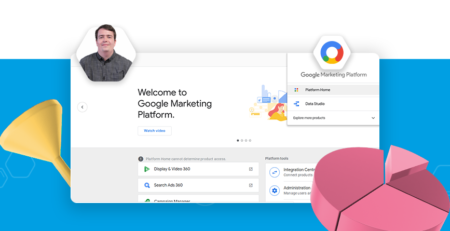Server Side Tracking: In With The Old, Out With The New
The history of Web Analytics in an emblematic light reads nothing less than a Hollywood flick.
Just like in a movie, when the long-forgotten hero comes back to life to prevent doomsday, in Web Analytics, Server-Side tracking has made a resurgence as the only sustainable solution to the impending doomsday of Client-Side Tracking.
At Brainlabs, we always strive to be a step ahead of the trends to provide the best quality of data to our clients. To bring this belief into action, we always look outwards and focus on the bigger picture. We outline our plan to face the oncoming challenges with actionable steps. Our recent observations paint a grim future of traditional Web Analytics practices. That would have been worrisome if we didn’t already have a solution in place. We will get to the solution in a bit. But first, let’s understand the problem.
If you are familiar with the Web Analytics space, chances are that you have heard of Client-Side Tracking. After all, it is only the most accepted norm of data tracking in present times. However, here is a brief description of it.
Client-Side Tracking is the most common way of implementing analytics and other 3rd party tags. This is accomplished by deploying your tracking code on each page of your site typically via a tag management system that sends the data to the appropriate servers via the users’ browser. The users’ browser then handles the communication of that information to the data collection service where the data is processed and made available for reporting.
Client-Side Tracking has many significant advantages like easy setup and flexibility in deployment. We get direct access to user’s behavioural data, such as cookies, URL parameters, user agent, referrer, and IP address. There is also a low barrier to entry via templates, pixels, or small amounts of JavaScript.
However, the recent onslaught of Data privacy measures has revealed a glaring caveat of Client-Side Tracking.
Forces like ITP (Intelligent Tracking Prevention) and ad/privacy blockers both deliberately target the capture of third-party analytics and advertising data on the client-side to prevent any data derivation.
Google Chrome has limited insecure cross-site tracking starting in February 2020 by treating cookies that do not include a SameSite label as first-party only and require cookies labelled for third-party use to be accessed over HTTPS. This will make third-party cookies more secure and give users more precise browser cookie controls.
Google is also developing techniques to detect and mitigate covert tracking and workarounds by launching new anti-fingerprinting measures to discourage these kinds of deceptive and intrusive techniques.
All these developments point towards the fact that third party data collection, the principle on which Client-Side tracking relies on might just end up being a thing of the past. The world is moving towards first-party data tracking with the consent of the user. In fact, browsers like Google Chrome are on the path of making third party cookies obsolete.
While currently, Web Analytics Implementation Engineers are working on the workarounds of the new regulations to continue with seamless data funnelling. None of those solutions are pragmatically sustainable. Every update will render the previous workaround useless. Hence, the need for an alternate sustainable solution is paramount.
The only long term, sustainable solution is to go back to basics. Back to Server Side Tracking.
Origin of Server Side Tracking
The origin of the concept of Server Side Tracking dates back to the early 1990s when a website statistics consisted primarily of counting the number of client requests (or hits) made to the webserver. Web servers record some of their transactions in a log file. It was soon realized that these log files could be read by a program to provide data on the popularity of the website.
Using that principle as the base, the present day methodology of Server Side Tracking is derived. The difference lies in its capabilities. With tools like Tealium EventStream, Segment, Google Tag Manager etc., implementing and maintaining Server Side Tracking has become even more seamless. Upcoming tools from Adobe and other market leaders are also expected to bring in a greater diversity in respect to the functionalities of Server Side Tracking.
Concept of Server Side Tracking
Implementation of Server-Side Tracking takes place when a pixel or tag sends data into your web server (or a different type of server) and then your web server passes that data to the destination system/server. This data could be used by a marketing automation platform, analytics provider, personalization tool, or another type of execution system. Server-side tracking removes the processing burden from a consumer’s device and moves it to the cloud.
Reasons why Server Side Tracking is the Future of Web Analytics:
- Since, in Server Side Tracking, the processing burden is moved from a consumer’s device to the cloud, it will lead to increased application and device performance. And as the conventional wisdom dictates; the faster application always leads to higher conversions.
- Server Side Tracking hides valuable information from getting exposed to the client-side i.e. the Data-Layer. With public access to the Data Layer, the website is susceptible to cyber-attacks such as “Injection Attacks”.
- Moreover, after interaction with our clients we have realized that there is a consensus on another dire reason for privatisation of the Data Layer. And that is to protect the confidentiality of the Business Strategy. With a publicly accessible Data Layer, competitors can directly see all the elements that are being tracked and easily reverse engineer the entire Web Analytics strategy and subsequently the business strategy. However, that was a necessity with Client-Side tracking. However, with Server Side Tracking, corporations can effectively privatise their Data Layer and also utilize all the capabilities of Web Analytics.
- Since the code which is meant to track the data of the website is inbuilt with the source code, Server Side Tracking ensures that there is no need for re-implementation when a site undergoes a User Interface Revamp(unless a drastic change in the logic with the new UI). One sustainable investment for years to come.
- And finally, with this methodology, the data funnelling is free from browser intervention. Since data is derived directly from the server, the data flow will not be hindered with any update in the third party cookie policy.
Due to the aforementioned reasons, Server-Side tracking comes as a definite sustainable solution for years to come because it covers all the present and future caveats of Client-Side Tracking.
However, it is safe to say that this methodology is still in its early stages of implementation. Hence, it does come with its own set of caveats. Since server side tracking involves adding the code snippets that tracks the user interaction, right into the source code, it makes it a bit cumbersome for debugging. Moreover, it restricts the ability to dynamically change functionality without touching the source code. A process that is quite straightforward with Tag Management systems.
Owing to these caveats, in its present state, Server-Side Tracking can’t replace Client-Side Tracking entirely. However, as it stands as the definite future of Web Analytics, we would suggest an approach of phasing out client-side tracking to reduce its dependency in a gradual manner.
In conclusion
The resurgence of Server-Side tracking as the only functional tracking methodology is an inevitable reality. Those who beat the curve will not face any sudden brunt and will be better equipped to have a seamless flow of data. The time for executing a change is the second after you realize the need for one. And the need for change is right now.





